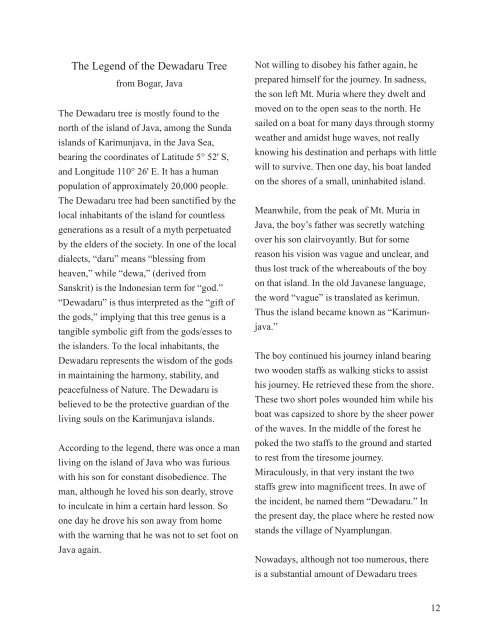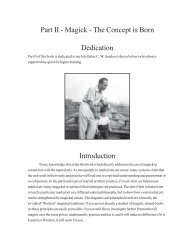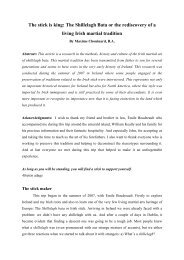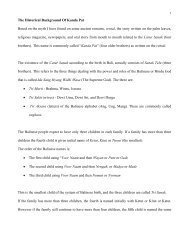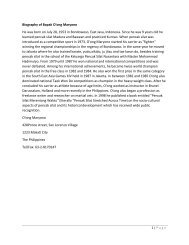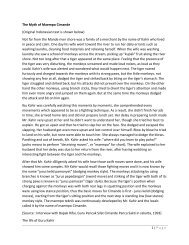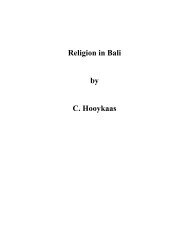Tenaga Dalam - Pukulan Cimande Pusaka
Tenaga Dalam - Pukulan Cimande Pusaka
Tenaga Dalam - Pukulan Cimande Pusaka
Create successful ePaper yourself
Turn your PDF publications into a flip-book with our unique Google optimized e-Paper software.
The Legend of the Dewadaru Tree<br />
from Bogar, Java<br />
The Dewadaru tree is mostly found to the<br />
north of the island of Java, among the Sunda<br />
islands of Karimunjava, in the Java Sea,<br />
bearing the coordinates of Latitude 5° 52' S,<br />
and Longitude 110° 26' E. It has a human<br />
population of approximately 20,000 people.<br />
The Dewadaru tree had been sanctified by the<br />
local inhabitants of the island for countless<br />
generations as a result of a myth perpetuated<br />
by the elders of the society. In one of the local<br />
dialects, “daru” means “blessing from<br />
heaven,” while “dewa,” (derived from<br />
Sanskrit) is the Indonesian term for “god.”<br />
“Dewadaru” is thus interpreted as the “gift of<br />
the gods,” implying that this tree genus is a<br />
tangible symbolic gift from the gods/esses to<br />
the islanders. To the local inhabitants, the<br />
Dewadaru represents the wisdom of the gods<br />
in maintaining the harmony, stability, and<br />
peacefulness of Nature. The Dewadaru is<br />
believed to be the protective guardian of the<br />
living souls on the Karimunjava islands.<br />
According to the legend, there was once a man<br />
living on the island of Java who was furious<br />
with his son for constant disobedience. The<br />
man, although he loved his son dearly, strove<br />
to inculcate in him a certain hard lesson. So<br />
one day he drove his son away from home<br />
with the warning that he was not to set foot on<br />
Java again.<br />
Not willing to disobey his father again, he<br />
prepared himself for the journey. In sadness,<br />
the son left Mt. Muria where they dwelt and<br />
moved on to the open seas to the north. He<br />
sailed on a boat for many days through stormy<br />
weather and amidst huge waves, not really<br />
knowing his destination and perhaps with little<br />
will to survive. Then one day, his boat landed<br />
on the shores of a small, uninhabited island.<br />
Meanwhile, from the peak of Mt. Muria in<br />
Java, the boy’s father was secretly watching<br />
over his son clairvoyantly. But for some<br />
reason his vision was vague and unclear, and<br />
thus lost track of the whereabouts of the boy<br />
on that island. In the old Javanese language,<br />
the word “vague” is translated as kerimun.<br />
Thus the island became known as “Karimunjava.”<br />
The boy continued his journey inland bearing<br />
two wooden staffs as walking sticks to assist<br />
his journey. He retrieved these from the shore.<br />
These two short poles wounded him while his<br />
boat was capsized to shore by the sheer power<br />
of the waves. In the middle of the forest he<br />
poked the two staffs to the ground and started<br />
to rest from the tiresome journey.<br />
Miraculously, in that very instant the two<br />
staffs grew into magnificent trees. In awe of<br />
the incident, he named them “Dewadaru.” In<br />
the present day, the place where he rested now<br />
stands the village of Nyamplungan.<br />
Nowadays, although not too numerous, there<br />
is a substantial amount of Dewadaru trees<br />
12


